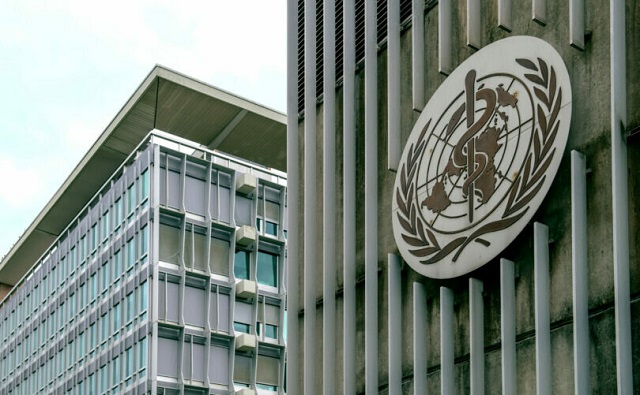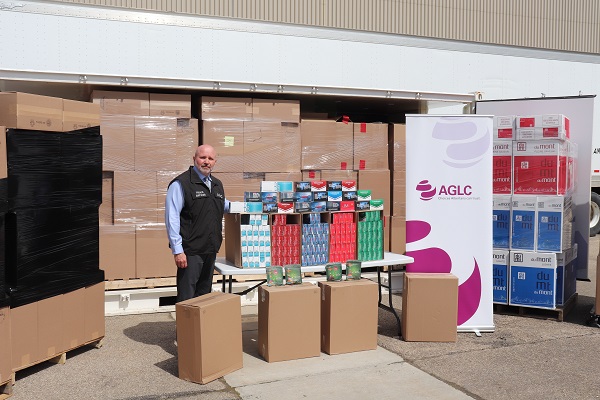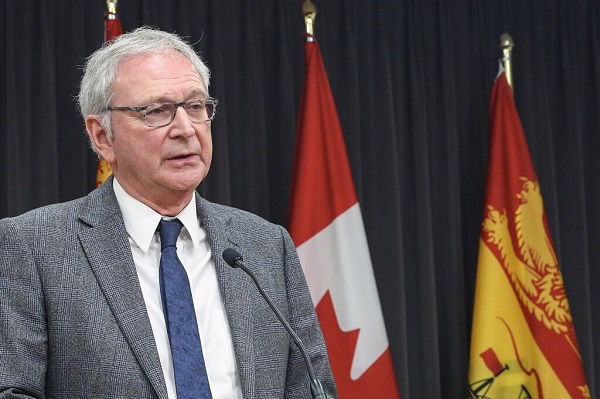Uncategorized
Dr. Malone: ‘Disease X’ is manufactured by the WHO to drive fear and public compliance

Building of the World Health Organization in Geneva, Switzerland
From LifeSiteNews
Don’t be fooled by Disease ‘X’ or ‘Y’ or ‘Z.’ These aren’t real diseases. They are being weaponized to acceptance of the transfer of both funding and authority to an unelected globalist non-governmental organization – the WHO.
I have been working in the public health sector for over 30 years. This includes a fellowship at Harvard and numerous other courses on bioethics. In all that time, there has been one clear message: for the emotional and physical wellbeing of the public, the government and public health must not incite fear without cause, and that to do so is unethical and immoral, akin to yelling “fire” or “active shooter” in a crowded movie theater. That public trust requires transparency and truth telling on the part of public health officials and government.
The CDC codifies this basic premise in their public health risk communication statement:
Be first, be right, be credible. That’s the mantra for crisis communication. Health communicators, whenever a crisis occurs, always be prepared to provide information to help people make the best possible decisions for their health and well-being. [Emphasis added]
READ: WHO’s Dr. Tedros says new global pandemic is matter of ‘when’ not ‘if’ at 2024 Davos summit
In 2018, the World Health Organization came up with the idea of “Disease X,” which is a placeholder for a disease that could be a potential cause of a future major epidemic or a pandemic. The original idea being that planning for an (imaginary) “Disease X” would allow for scientists, public health officials, and physicians to design the best possible practices for a future epidemic or pandemic. They then formally added “Disease X” (an imaginary disease) to the top priority list of pathogens.
The idea behind Disease X was later weaponized to create a fog of fear in the public as well as governments. The weaponization started with COVID-19 communications. In a 2021 study, it was found that the “the only predictor of behavior change during COVID-19 was fear.” Despite their finding that such fear was related to a decrease in both emotional and physical wellbeing, the authors concluded that using fear to drive the public into compliance was the only path forward for public health. The authors write:
However, fear of COVID-19 was related to decreased physical and environmental wellbeing. Overall, these results suggest that ‘fear’ and anxiety at the current time have a functional role, and are related to increased compliance for improving public wellbeing.
‘Damn the torpedoes full steam ahead’
Without further questioning of the basic ethics behind using fear to drive compliance, this logic then became the consensus of public health officials and governments throughout the world. That being that the use of fear to get compliance for vaccines and vaccine mandates, vaccine passports, masking, lockdowns, social distancing, school closures, etc., was acceptable in the name of public health. That the decreased emotional and physical wellbeing of the general public by the promotion of fear tactics was an acceptable side effect.
Exit COVID-19… stage left. Enter ‘Disease X’… stage right
And just like that, “Disease X” has been substituted for COVID-19.
Without any qualms whatsoever, The World Health Organization (WHO) has gone from launching a global scientific process using Disease X as a model, to using “Disease X” as a propaganda driver to drive fear of an imaginary infectious disease. Then to use that fear to get public and governmental compliance for a new pandemic treaty, and more money for the WHO. Such weaponized fear (fearporn) also has been found to elicit more public compliance for public health measures, such as masking, social distancing, vaccines, and lockdowns.
The gradual shift was subtle. In April 2023, the WHO wrote:
Disease X represents the knowledge that a serious international epidemic could be caused by a pathogen currently unknown to cause human disease. The R&D Blueprint explicitly seeks to enable early cross-cutting R&D preparedness that is also relevant for an unknown ‘Disease X.’
In 2024, the WHO gave the general warning (without any data what-so-ever) that the imaginary Disease X could result in 20 times more fatalities than COVID-19.
Of course, there are some people who say this may create panic. It’s better to anticipate something that may happen because it has happened in our history many times, and prepare for it.
Bottom line is that Director-General Tedros now openly admits that the WHO is using fear to drive governments to open their pocket books and to drive compliance for the new pandemic treaty.
And the WHO’s fear mongering is working, the House recently introduced a new bill H.R.3832 – Disease X Act of 2023.
The bill reads:
This bill expands the priorities of the Biomedical Advanced Research and Development Authority (BARDA) to specifically include viral threats that have the potential to cause a pandemic.
In particular, the bill expands the scope of innovation grants and contracts that may be awarded by BARDA to specifically include those that support research and development of certain manufacturing technology for medical countermeasures against viruses, including respiratory viruses, with pandemic potential. It also expands BARDA’s authorized strategic initiatives to include advanced research, development, and procurement of countermeasures and products to address viruses with pandemic potential.
In order to understand the significance of this bill, it is important to understand what BARDA is:
(BARDA)’ is a U.S. Department of Health and Human Services (HHS) office responsible for the procurement and development of medical countermeasures, principally against bioterrorism, including chemical, biological, radiological and nuclear (CBRN) threats, as well as pandemic influenza and emerging diseases.
This bill is a sneaky backdoor to significantly expand the mission space of BARDA to include research into viruses. In the past, BARDA has been limited in their scope, so as to not compete with NIH. The expansion of yet another agency with very few limits on their scope is not in the public interest.
So, here is an easy ask. Contact your House representative and let them know how you feel about H.R.3832 – Disease X.
In the meantime, don’t be fooled by Disease “X” or “Y” or “Z.” These aren’t real diseases. They are made-up. They are being weaponized to gain compliance, drive fear, and to gain acceptance of the transfer of both funding and authority to an unelected globalist non-governmental organization – the WHO.
Yes, we have a problem with ongoing gain-of-function research and China is continuing on with its dangerous gain-of-function experiments. By all accounts, these are being conducted in poorly controlled laboratory environments. But such experiments aren’t limited to China; they are also happening in the USA. In 2023, Boston University School of Medicine scientists created a highly lethal SARS-CoV variant, which they then tested on mice.
Furthermore, the Biological Weapons Convention does not prohibit biological weapons, as an overlooked loophole allows for development, manufacture, and stockpiling of such for prophylactic, protective, or other peaceful purposes. The convention must be re-negotiated. The Biological Weapons Convention also does not adequately address gain-of-function research, which must to be banned worldwide.
These are concrete ongoing issues that the World Health Organization is not addressing. If the WHO’s motive is to stop future threat of infectious disease, why are they not working on these issues?
How far the WHO and public health has fallen…
Reprinted with permission from Robert Malone.
Uncategorized
RCMP recruitment failure has Alberta advocacy group calling for Provincial Police Service

News release from Free Alberta Strategy (A Strong And Sovereign Alberta Within Canada)
“Make no mistake, we are paying for these services that we aren’t receiving. Alberta’s taxpayers are paying tens of millions of dollars for nearly 400 vacant RCMP officer positions – for boots that are not on the ground.”
A recent report from the Royal Canadian Mounted Police (RCMP)’s independent Management Advisory Board had findings that are nothing short of alarming:
“Federal policing has now arrived at a critical juncture of its sustainability, which present risks for the national security and safety of Canada, its people, and its interests,” says the report.
After over a year of diligent study, the Board has been tirelessly firing off flares, signalling to all who will listen: the very foundation of our national public safety apparatus may be at risk of faltering.
This is doubly problematic because, as you well know, the RCMP is also responsible for boots-on-the-ground policing in large parts of the country, including many rural and remote areas – including in Alberta.
Rural crime has been a longstanding issue in Alberta, and social disorder continues to make headlines nightly.
Alberta Minister of Public Safety, Mike Ellis, took to social media platform X (formerly known as Twitter) to express his opinion:
“The independent report finds the RCMP has struggled in recent years to recruit and retain regular members, a problem that’s particularly acute in federal policing. This is not about the hard-working men and women on the frontline: they are doing everything they can. The reality is the RCMP do not have enough officers to police communities in Canada effectively.”
Ellis has been ahead of this story for months now.
In March, Ellis stated that:
“… on average, Alberta has an RCMP officer vacancy rate of 20 per cent. This means that Alberta is only being served by 1,522 of the 1,911 RCMP officers that the federal government has authorized for Alberta.”
“Make no mistake, we are paying for these services that we aren’t receiving. Alberta’s taxpayers are paying tens of millions of dollars for nearly 400 vacant RCMP officer positions – for boots that are not on the ground.”
The consequences of this capacity crisis are far-reaching.
Not only does it jeopardize the safety of Albertans, but it also undermines the credibility of Canada’s federal police force on the international stage.
With limited resources and personnel, the RCMP’s ability to address pressing national and global security concerns is severely compromised.
The Management Advisory Board, created in 2019 by the federal government to provide external advice to the RCMP commissioner, set up a task force in the fall of 2022 to study the federal policing program.
Overall, the report says budget and personnel shortfalls have left the RCMP “operationally limited,” restricting the number of cases it can take on annually.
Here are some more highlights from the report:
“Canada and its people have already begun to see the repercussions of the federal policing program being stretched thin.”
“Federal policing’s overall eroding capacity may have implications for the credibility of Canada’s federal police force and its investigations on the international stage.”
“Ultimately, this may influence Canada’s overall approach and standing in international politics, including its ability to advance global priorities.”
Clearly, we cannot afford to wait any longer.
Municipalities can ease the burden on our national security services by establishing municipal policing.
Several cities in Alberta already have their own police authorities, and the provincial government is providing funding for others interested in exploring this option.
Grande Prairie is already in the process of establishing their own municipal police service.
No word on how many other municipalities have taken the government up on their offer.
Unfortunately, President of Alberta Municipalities Tyler Gandam (also Mayor of Wetaskiwin) is featured prominently on the National Police Federation’s “Keep Alberta RCMP” website.
Interestingly, the Keep Alberta RCMP website doesn’t mention the fact that the advisory board even exists.
It doesn’t mention the report.
The notion that our federal policing infrastructure teeters on the brink of instability while Gandam appears to be asleep at the wheel, is deeply disconcerting.
The safety and security of Albertans must remain our top priority.
We cannot afford to wait any longer.
The time has come for the province to take swift and decisive measures to bolster policing capabilities in Alberta.
It’s time for Alberta to seriously consider the establishment of an Alberta Provincial Police Service.
It has been one of the core tenets of the Free Alberta Strategy.
If you agree, please reach out to your municipality and ask them to take steps to protect your community.
Together, we can keep Alberta safe.
Regards,
The Free Alberta Strategy Team
P.S. We’re hoping you’ll consider contributing to our cause. Your generous donation helps us make a positive impact in our community. No need to worry about any hold-ups or threats here. We’re just passionate about making a difference, and your support goes a long way in helping us achieve our goals.
Uncategorized
Making Alberta a geothermal energy leader

Eavor announces it’s the #1 geothermal energy startup company in the world – January 2024
Alberta is creating Canada’s first geothermal test site to advance drilling innovation, reduce emissions and create jobs.
Geothermal energy uses naturally occurring heat within the earth to heat water and buildings and generate power, with few emissions or environmental impacts. Alberta has vast pockets of heat below ground, making the province Canada’s geothermal leader, but testing and developing new technologies can be a barrier for many companies. Unlike the United States, Japan and other countries, Canada does not currently have an open-access test site to help spur innovation.
Alberta is taking the first steps to create a new Alberta Drilling Accelerator. This groundbreaking facility would be the first of its kind in Canada, establishing Alberta as a global hub for geothermal technology. This will drive new innovations in geothermal and other clean energy projects that can reduce emissions and power communities around the world.
To kick-start the project, the Alberta government is investing $750,000 to conduct a feasibility study led by Calgary-based Eavor Technologies and other stakeholders. The study is the first step in assessing the proposed facility. It will include identifying a site, business planning, research on the governance model, an economic impact analysis and stakeholder engagement that will lay the groundwork for the initial planning stages of the project.
“Alberta has been a global energy leader for more than a century, renowned for our skilled workforce, innovation and one of the largest oil and gas reserves on the planet. The proposed Alberta Drilling Accelerator presents enormous potential to help our province lead the next wave of energy projects here at home and around the world that reduce emissions, create jobs and enhance energy security.”
The Alberta Drilling Accelerator would help companies test out and develop new geothermal drilling techniques or technologies to reduce emissions and drive growth across the clean energy sector. It would be an open-access, technology-agnostic drilling test facility capable of drilling in challenging environments, including deep depths, high temperatures and different rock types.
The accelerator also would help speed up the development of carbon capture, utilization and storage; helium; critical minerals; and other clean technologies and commodities that rely on Alberta’s drilling sector. All of this helps attract investment and bring new technologies to scale in Canada.
“With cumulative geothermal investment poised to reach $1 trillion by 2050, a geothermal arms race is very much underway to commercialize novel drilling techniques that accelerate geothermal development – exhibited by testing facilities in the United States, China and Iceland. As Canada’s first geothermal test bed, the Alberta Drilling Accelerator will help bring geothermal technologies to scale, supporting companies like Eavor. We commend the Government of Alberta for this bold initiative.”
“We are proud to witness Eavor, a CDL-Rockies alumni company, create new opportunities for innovators like themselves to advance the adoption of energy transition technologies like geothermal. The Alberta Drilling Accelerator will further solidify Alberta’s position as a leader in the global sustainable energy landscape.”
If the feasibility study shows the facility is economically and environmentally viable, and if the project is approved by the Alberta government, the facility will start taking shape at the selected site and drilling could start as early as 2025.
“Canada is home to the most advanced drilling technology in the world. Not only do our members support the responsible development of oil and gas, but we are integral in the extraction of new energy resources like geothermal and critical minerals. Our workers are at the epicentre of Canada’s energy transformation. Our people, technology and processes are leading the way towards a more diverse energy future. The Alberta Drilling Accelerator is a government-enabled policy approach to expand Alberta’s drilling capacity and reach its full potential as the world’s most diverse and technologically advanced producer and exporter of sustainable energy and critical minerals.”
“The Alberta Drilling Accelerator is a testament to Alberta’s innovative and entrepreneurial spirit. Leveraging our oil and gas sector expertise, Alberta is poised to become the global leader in developing new geothermal technologies that will play an integral role in reducing emissions while supporting job creation.”
Quick facts
- The Canadian Association of Energy Contractors estimates that one active drilling rig, whether drilling for natural gas or geothermal, creates approximately 220 direct and indirect jobs and
$1 million in tax revenue. - In 2019, Eavor received $2 million in provincial funding through Emissions Reduction Alberta and Alberta Innovates for the world’s first closed-loop geothermal system.
Related information
-

 Alberta23 hours ago
Alberta23 hours ago30 million contraband cigarettes valued at $25 million dollars seized in Alberta
-

 COVID-193 hours ago
COVID-193 hours agoCOVID Lab Leak: Over four later, EcoHealth Alliance funding is finally suspended
-

 Alberta2 days ago
Alberta2 days agoProvince announces next step to revamped health care system
-

 Alberta1 day ago
Alberta1 day agoPharmacist-led clinics improve access to health care: Lessons from Alberta
-

 Health2 days ago
Health2 days agoPrivate Footage Reveals Leading Medical Org’s Efforts To ‘Normalize’ Gender Ideology
-

 Alberta2 days ago
Alberta2 days agoRed Deer Hospital Lottery – Second Chance Early Bird Prize!!!
-

 armed forces2 days ago
armed forces2 days agoTrudeau government has spent $10 million promoting DEI in the military as recruitment flounders
-

 COVID-192 days ago
COVID-192 days agoMore victories for freedom as ArriveCAN charges dropped and fines reduced









